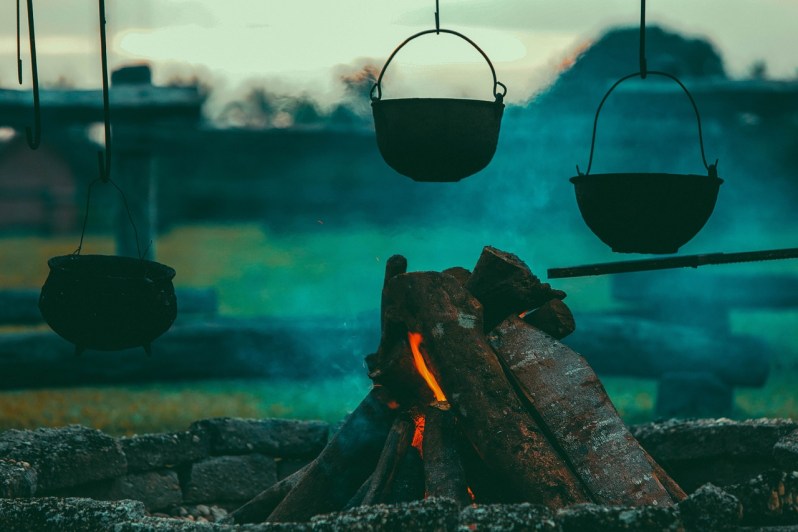
Knowing how to build a fire is an essential skill in both recreational and survivalist situations. But if you want to make the most of your fire, considering the type of wood you’re using can help you optimize it.
This is useful if you have a small amount of wood, are in an extremely cold environment, want to practice fire safety or plan on cooking meals outdoors. The wrong wood could be too smoky, burn out quickly, or even explode into sparks.
On the other hand, using the wrong wood might not give off enough heat, only produce smoke, and take forever to cook things.
You don’t need to be a tree expert to figure out which wood is best for you. Rather, it’s best to stick to these top options. They all offer a consistent hot burn, but they also come with unique features that you may find more helpful depending on what you plan on doing near the fire.
So here’s a list of the best wood for campfires to use the next time you’re warming up under the vast night sky.

Understanding hardwood vs softwood
I know I said you didn’t have to learn everything about trees to understand firewood. But you do need to understand one fundamental difference, and that’s the distinction between hardwood and softwood.
Softwood is a faster-burning, lighter wood that ignites at a low temperature. This makes them easier to get started and means that you’ll get lots of bright, fast-catching flames.
Hardwood logs come from deciduous trees and tend to be much denser than their counterpart. These heavy logs will take a while to heat up and give off more smoke in the process. With patience, hardwood will create a tremendous amount of radiant heat due to its long-lasting burn.
As you can see, these types of wood can make a huge difference in how your fire burns. If you know you want your fire to burn quickly so you can enjoy a quick outdoor meal, go with softwood. If you want to stay by the fire for over an hour, hardwood will work best.
It’s a good rule of thumb to go with hardwood if you can’t decide. This is because hardwood tends to burn more efficiently, and although it may be harder to start, it can withstand winds, light rain, and even snow.

7 campfire woods to keep you toasty all night
Here’s the best wood to burn when you want the fire to keep going all night long with few surprises and a brilliant light display.

Maple: Long-lasting warmth
Maple is a classic firewood that commonly grows in both the U.S. and Canada. This means you’ll be able to find it at campsites and parks easily during your travels. Maple burns slowly and hot, with a steady flame that can last for hours.
It’s known for having a low moisture level and a high BTU rating, which means it produces a lot of heat per unit of volume. Because maple trees are rich in sap, they will also give off a pleasant aroma when burning.
But beware that this sap and excess moisture can also lead to a lot of smoke, so start your maple wood fire slowly and use small logs with lots of airflow at the base.

Oak: Steady, strong heat
Oak is a very strong wood, which is why it’s such a popular choice for building furniture meant to last for decades. This durability also makes it a powerhouse when it comes to building fires. Oak is great for large gatherings or long nights at the fire.
If you have a big group coming to enjoy the oak fire, make sure to have them help you with the heavy lifting. Oak is one of the heaviest firewood available, so it may not be the best choice for those who are carrying camping or taking backpacking trips.
It’s also essential to give oak a long time to season or dry out because it’s very dense and holds water for a very long time. Seasoned oakwood has a rich, woodsy scent accompanied by a dark brown or golden color.

Ash: Lightweight for backpacking
It’s a bummer that oak isn’t the best choice for longer outdoor trips, but not to worry, Ash is a fantastic alternative. This lightweight wood is quite tough, making it a perfect solution for those who won’t want a lot of bulk.
Backpackers can easily light ash by making a friction fire bow drill, making it a great choice for those using minimal equipment. It’s also quite easy to split, so you can create the perfect-sized logs with no waste for your outdoor cooking needs.
It’s also a great choice for radiant heat for those who don’t want a lot of brightness from flames, as the wood quickly burns down to a toasty ash bed.

Hickory: The perfect balance of time and heat
If you’re looking for a good even-burning wood, try out hickory. This tree’s wood is very sturdy and takes longer than maple to ignite, but once it does, it will give off a lot of heat for an extended period.
Hickory has a BTU output that will outlast both sugar maple and red oak. Many people use hickory when they’re smoking food because you can count on it to burn for hours. It imparts a very rich flavor to meats for those who prefer a hearty meal after a day in the wilderness.
This option may be slightly more expensive than more common varieties on this list. But it’s relatively easy to find and won’t burn too quickly, which makes it an excellent value.

Pine: Quick burning
Pine is a surprisingly diverse tree, and there are over 120 varieties of them on the planet. So it’s pretty easy to find it no matter where you’re starting your fire, and it lets out a familiar aromatic smell that’s nostalgic yet fresh.
Pine takes only a few minutes to light up, which is great for getting the fire started quickly. It’s low density and has a very good BTU output, leading to bright robust fires.
Much like ash, it’s best for fast fires that provide a lot of light and heat but won’t last too long. Make sure to have plenty of pine on hand to keep adding more logs as needed.

Birch: Bright flames
Birch is an attractive and unique-looking wood that’s commonly used for burning in fireplaces but is also a popular choice for the great outdoors. The wood itself cures and dries rather quickly, especially for its density. However, the thick bark often holds extra moisture or sap, so consider peeling it off before lighting the fire if it appears to still be fresh.
The bark also makes excellent kindling and shavings for starting a fire with minimal effort when it’s well dried. It produces consistent medium flames that are perfect for stick-roasting over the fire.

Cherry: Robust warm fires
Cherrywood offers the best of both worlds, with a composition that sits between a hardwood and a softwood. It is a good option for those who want to enjoy the warmth of hardwood but don’t have time to wait for it to season properly.
This firewood is also ideal for wood fire cooking because of its mild smoke that won’t overpower the flavor of your food. It gives off a nice aroma without too much soot or ash and is easy to control as you rotate logs throughout the night.

Build your fire correctly for the best results
Now that you know the best wood to burn in your campfire, it’s time to turn your attention to a few more important elements of a great fire to consider. These steps will make the most out of the qualities of your wood and make your fire more resilient and even overall.
- Start with good kindling, which allows your fire to build heat in the core. You can either invest in firestarters or collect small pieces of natural debris around your site. You can also use an axe to make thinner strips of your existing firewood.
- Stack your wood for optimal airflow. Some woods do better with a lot of oxygen, while others do better with less. Research the specific wood you have to determine how best to stack it.
- Dry your wood properly, or buy well-seasoned wood. This gives you the best chance of lighting your fire and significantly reduces smoke levels. If you’re cutting the wood yourself, it may take 1 or 2 years to fully dry.
- Stay vigilant around your fire. If you put too many (or not enough) logs on with consistency, the heat will die off, and you’ll have to restart the process again.
While these are the basics when it comes to fire-building best practices, some pros spend years perfecting the art of the campfire. You can learn from these experts and, of course, adapt their tips to your preference as your skills build
Eventually, you’ll find which wood and fire building method works best for you, leading to great flames and heat every time.
Editors' Recommendations
- Hitch up with the 7 best off-road trailers ready to take you anywhere in 2024
- The best camper vans for adventurous luxury living in the great outdoors
- Keep your irons and woods cean: The 7 best golf brushes
- Campfire cooking: This is the absolute best way to make a pot hanger
- Dust off your gear, it’s time to hit the trail: The spring hiking tips you need



